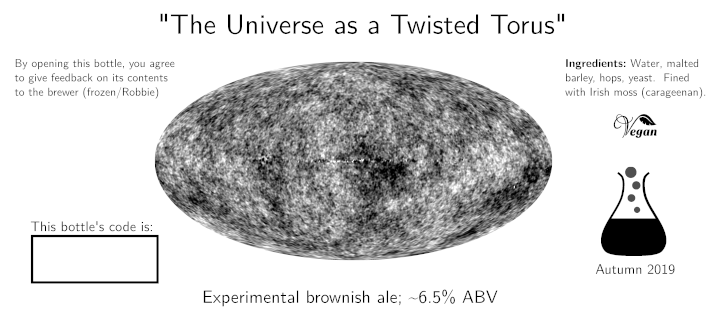Label: Twisted Torus
I’m far from a graphic designer, but I do make these beers; the beers go into bottles, and bottles need labels. So I do what I can, and generally my tools Inkscape and to a lesser extent GIMP keep me from making a complete fool of myself. (I made some process changes this time, doing almost all the construction in Inkscape, which worked much better for me.)
This is the third label I’ve designed to completion (i.e., printable and ready to go on bottles). I’m posting it in advance of another post about the beer itself, which is currently bottle conditioning. If/when I re-brew and make posts about the beers the previous two go with, I may post them as well, but no promises. (Ask me in person if you’re interested.)
So here’s a PNG render (because web browsers are bad at SVG):

If you want the actual SVG, let me know, but there’s nothing complicated there.
Sources of the pieces are as follows:
-
The flask is a modified version of this CC0 image.
-
The vegan logo is a similarly doctored version of this CC0 image
-
The middle graphic was created by NASA/WMAP
-
The font is Latin Modern Sans
I wanted to emphasize the “experimental” aspect of this one - I’m expecting some of the bottles to be decidedly odd. So there’s a flask (very sciency) and space for me to write bottle code (which will probably be in marker).
This actually led me to the font as well. The LaTeX typesetting system, which is used for many science papers, has a distinctive default font (Computer Modern), which seemed a natural choice. However, since LaTeX is a very complicated tool, it’s not easy to render this font directly. Instead, I’m using a derivative (Latin Modern), which behaves as a normal TTF. It’s significantly less effort, differences aren’t really noticeable, and I didn’t really want ligatures anyway.
Without giving away too much, part of the experiment involves some Norwegian farmhouse yeast (kveik). Use of this yeast has involved the (now) unusual practice of storing and re-pitching the yeast cultures, often drying them out in the interim. A block of wood with holes (“yeast log”) or a wooden loop (“yeast ring”) would be lowered into the active fermentation, and then the yeast would dry on it. The next batch would be started by placing the wood into wort and allowing the yeast to rehydrate. There’s good evidence that a wooden puzzle construction in the shape of a twisted torus was used as a yeast ring. (For more on this topic, I suggest Susan Verberg’s “Scandanavian Yeast Rings: The curious case of the Twisted Torus”.)
Determining the shape of the universe is a fascinating problem which draws from many fields, none of which I understand sufficiently to actually discuss well. However, given what we know, a toroidal (bagel) shape remains a reasonable possibility. Much of our data comes from readings taken by the aforementioned WMAP from NASA, so it’s not a far leap to using their data here as well. (I’m using the greyscale data, which is unfortunately not the most recent, because I don’t like working in color and the colors used for the later releases don’t readily lend themselves to greyscale conversion.) To explore this rabbit hole fully, you could start at the wikipedia page.
I don’t think anyone has seriously proposed a twisted torus as the universe shape. As I understand it, one consequence of such a shape would be the observability of the same object in multiple directions from the same vantage point. This would be extremely difficult to actually notice, though, because our “observation” happens at the speed of light, and presumably the object would not be equidistant in both directions.
The wort I created is indeed brown, though very little else of the experiment is stylistically appropriate for a brown ale - so “brownish” (which is also a reference not worth tracking down).
Finally, finings are added to beer (and wine etc.) to clarify and filter. Irish moss (despite the name, it’s a seaweed) is about the least distressing substance used for this purpose. Unfortunately, listing ingredients is rare, and listing finings basically never happens. I feel it’s important to include ingredients (and vegan mark) to normalize this and to make life easier for those with allergies/dietary restrictions. Until then, barnivore keeps a database of booze producers who have indicated the status of their product.